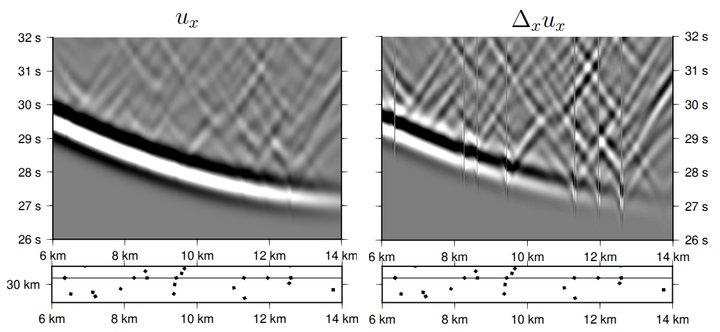 Illustration of DAS sensitivity (right) to small-scale heterogeneities in the subsurface.
Illustration of DAS sensitivity (right) to small-scale heterogeneities in the subsurface.
Abstract
Distributed Acoustic Sensing (DAS) is a photonic technology allowing to convert fiber-optics into long (tens of kilometers) and dense (every few meters) arrays of seismo-acoustic sensors which are basically measuring the strain of the cable all along the cable. The potential of such a distributed measurement is very important and has triggered strong attention in the seismology community for a wide range of applications. In this work, we focus on the interaction of such measurements with heterogeneities of scale much smaller than the wavefield minimum wavelength. With a simple 2-D numerical modeling, we first show that the effect of such small-scale heterogeneities, when located in the vicinity of the instruments, is very different depending on whether we measure particle velocity or strain rate: in the case of velocity, this effect is small but becomes very strong in the case of the strain rate. We then provide a physical explanation of these observations based on the homogenization method showing that indeed, the strain sensitivity to nearby heterogeneities is strong, which is not the case for more traditional velocity measurements. This effect appears as a coupling of the strain components to the DAS measurement. Such effects can be seen as a curse or an advantage depending on the applications.
This paper delves into the unique characteristics of Distributed Acoustic Sensing (DAS) measurements, particularly their interaction with subsurface heterogeneities that are much smaller than the seismic wavelength. We demonstrate through numerical modeling and theoretical analysis that DAS, which measures strain, exhibits a significantly higher sensitivity to these small-scale features compared to traditional particle velocity measurements.
This enhanced sensitivity arises from the coupling of strain components to the DAS measurement. Understanding this phenomenon is crucial for both interpreting DAS data accurately and for leveraging this unique sensitivity for new applications in seismology and subsurface imaging.